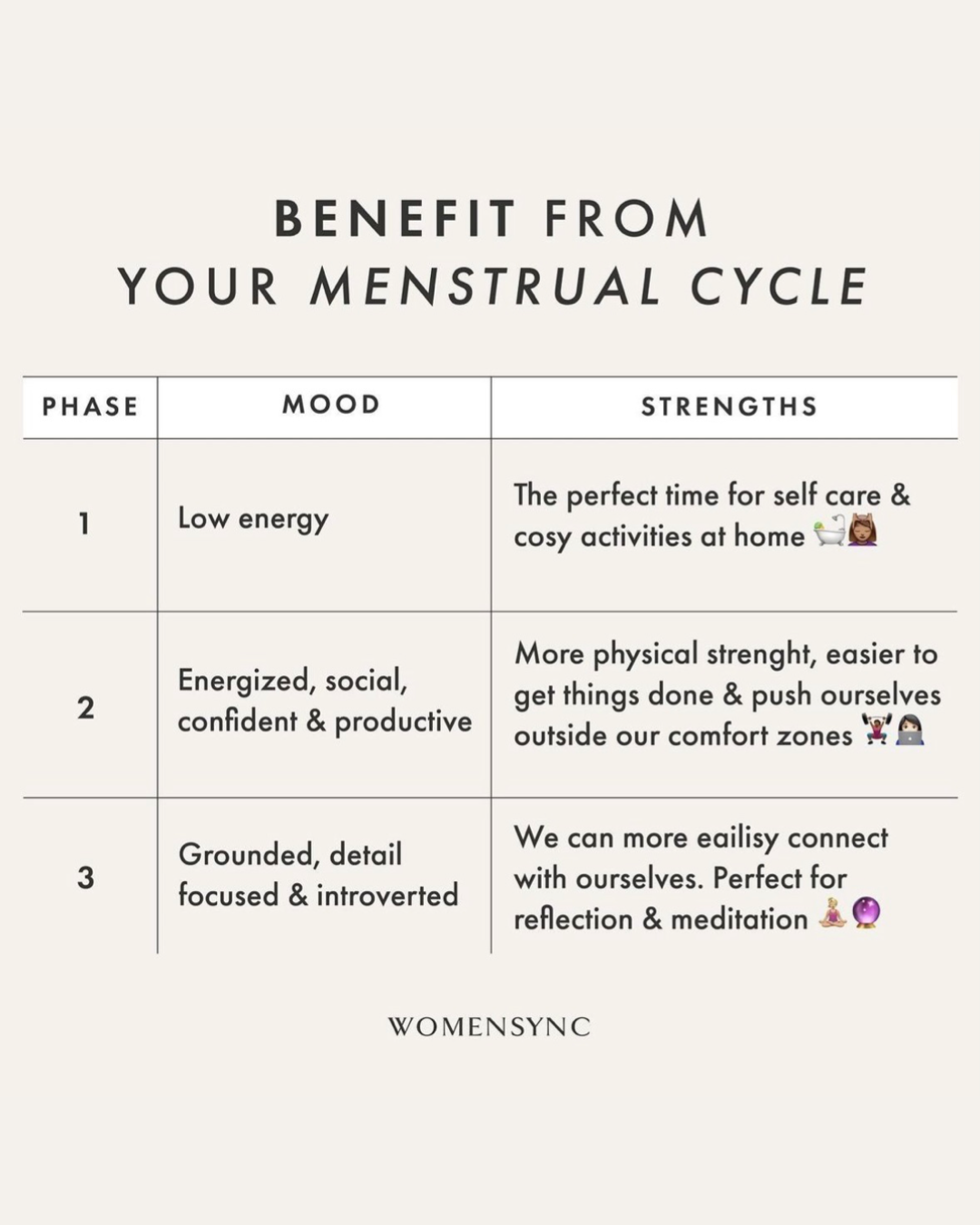Understanding what exactly your body needs in the different phases of the menstrual cycle when it comes to nutrition, recovery, exercise or work - is an incredible tool that can help us get the most out of ourselves during the month. In this article, you'll get the insights on how to make the most of the different phases of the menstrual cycle so you can be at your full potential, all month long.
Suggestion: Understanding the phases of the menstrual cycle is a powerful tool for gaining a deeper understanding of yourself, your body and what you may need during the month. S
Phase 1 menstrual cycle
Phase one is the days when you have your period, i.e. from the first to the last day of your period. How many days a period is different from person to person and can also vary slightly from menstrual cycle to menstrual cycle. The hormones are at their lowest at the beginning of the period, which can be reflected in how we can experience our mood and our body physically at the beginning of phase one.
At the beginning of the period, many people recognize themselves in being a little more tired than usual. It depends on the processes that take place in the body when we have to get rid of the mucous membrane (what becomes the period). As the days go by, the energy will increase more and more. This is because estrogen is raised, which can also have other effects such as feeling inspired around new ideas and feeling a drive to want to put them into action. Phase one is the start of a new cycle which is really perfect for making sure to start new projects or habits!
Tips when you have your period (phase 1)
- Set aside time at the beginning of the phase to take care of yourself and give yourself extra love.
- To reduce any symptoms linked to menstruation, you can use exercise (in the forms that feel right for the body) as a tool to increase your well-being.
- Take the opportunity to use the energy that rises within you for a fresh start and to initiate positive change.
- As the energy increases, you can make sure to schedule meetings and social events for the end of the phase where you can get the most out of yourself and your capacity.

Phase 2 of the menstrual cycle
Phase two begins when the period ends and lasts until ovulation, which usually occurs around day fourteen of a twenty-eight-day cycle. If you have a shorter cycle, ovulation occurs earlier and if you have a longer cycle, it occurs later.
During phase 2, estrogen continues to increase and peaks at ovulation. Estrogen is the hormone that makes you experience higher energy, that you feel more social and that you can feel a biological confidence boost. The hormone testosterone also peaks at ovulation, which contributes to feeling extra strong, persistent and light in the body. It is before and during ovulation that the body is biologically set up to reproduce, which means that you are right on these days - this is also often reflected in increased sex drive! You may simply experience an increased attraction or desire to be physically close to other people. The days before and during ovulation when we are fertile are called "the fertile window" and these are the days you can get pregnant.
Tip phase 2 (before ovulation)
- You are at your strongest physically in phase two, use your physical capacity and challenge yourself.
- With your hormonal confidence boost, this is the time to dare to push yourself outside your comfort zone - now is when it feels easiest.
- Your high energy provides a perfect opportunity to be a "doer". You are in your productive prime.
- This is a great opportunity to socialize and network as you can feel at your most outgoing and self-confident.
- With the increased testosterone, this is the phase to plan a date with your partner or someone you are attracted to.
- Give yourself room to recover so you can maintain a balanced energy in the long term.

Phase 3 of the menstrual cycle
Phase three begins the day after ovulation and lasts until you get your next period. It is during phase 3 that the hormones shift the most, which is often reflected in the physical, emotional and mental fluctuations that can be experienced in this phase. If the hormones are not completely balanced, you can feel how moods and emotions can be turned upside down from one day to the next. Maybe you feel at your best one day only to feel completely down the next day. Maybe you recognize yourself? If you do, it's important to remind yourself that it's just your hormones and that it's a phase that will pass. It is therefore in phase three that you can experience various PMS symptoms, which can be experienced both physically and emotionally. Continue to pay attention to when your symptoms appear and chart the patterns from month to month.
Tip phase 3 (before period)
- This phase is perfect for giving yourself space for reflection and personal development, to look inward. Give yourself time to read, write or create.
- Give yourself time to do things that make you feel good. Plan activities that give you an emotional lift.
- Physical proximity and touch can give you increased feelings of happiness and thus be a good tool for increased well-being.
- Do not make revolutionary decisions: do not end relationships, do not close projects, companies and ideas, do not resign from work. Wait until the next phase and see if the feeling lasts.
- When you live a lifestyle in sync with your menstrual cycle, you will experience fewer period-related discomforts in phase 3.

Krug, R., Finn, M., Pietrowsky, R., Fehm, H. and Born, J., 1996. Jealousy, general creativity, and coping with social frustration during the menstrual cycle. Archives of Sexual Behavior, [online] 25(2), pp.181-199. Available at: <https://link.springer.com/article/10.1007%2FBF02437935>
Little, A., Jones, B. and Burriss, R., 2007. Preferences for masculinity in male bodies change across the menstrual cycle. Hormones and Behavior, [online] 51(5), pp.633-639. Available at: <https://www.sciencedirect.com/science/article/abs/pii/S0018506X07000360>
Roney, J. and Simmons, Z., 2013. Hormonal predictors of sexual motivation in natural menstrual cycles. Hormones and Behavior, [online] 63(4), pp.636-645. Available at: <https://www.sciencedirect.com/science/article/abs/pii/S0018506X13000482>
Saad, G. and Stenstrom, E., 2012. Calories, beauty, and ovulation: The effects of the menstrual cycle on food and appearance-related consumption. Journal of Consumer Psychology, [online] 22(1), pp.102-113. Available at: <https://www.sciencedirect.com/science/article/abs/pii/S1057740811001021>

